Knauf super-flooring system: dry screed using German technology
To date, the Knauf system is the only one in the world where wet processes are not used. But the main drawback of a concrete screed - absolutely all of its types - is that you can only start living in a room with such floors for 28 days, and not earlier. At the same time, as prefabricated floors are ready for operation on the second day. Here is such an interesting technology offered to the whole world by a German manufacturer. You can easily master it!
Content
What is a KNAUF system?
So, KNAUF OP 13 floors are non-drift and easily assembled dry assembly structures designed for installation in public and residential buildings, where there are:
- Increased requirements for soundproofing floors.
- There is no way to carry out “wet” finishing processes.
- Limited deadlines for all work.
- A serious rise in floor level is required.
- It is important to reduce the load on the floor.
- It is necessary to shelter technical networks in a dry way.
Moreover, Knauf floors can be arranged both on concrete and on wooden coatings. But for them there are their own requirements for premises according to SNiPs:
- Dry, normal and humid conditions.
- Non-aggressive environment, with moderate and weak intensity of mechanical stress.
- There are no restrictions on fire resistance and number of storeys of the building, as well as engineering-geological and climatic conditions.
The Knauf superfloor is also officially allowed to equip in damp rooms, like showers and bathrooms, but only with proper waterproofing. In this case, lay the Knauf or Flekhendikhtband waterproofing tape at the junction of the floor with the walls, and cover the entire surface with waterproofing.
All prefabricated floor bases using KNAUF technology are divided into the following types: Alpha, Beta, Vega and Gamma. Let's look at their differences in more detail:
- Alpha - construction on even floors.
- Beta - a structure on a substrate of heat-insulating porous fiber materials, but also on even ceilings.
- Vega is a structure on a substrate, which is a leveling layer of dry backfill.
- Gamma - a construction of a combined substrate of sound and heat-insulating porous fiber materials, also along the leveling layer of the backfill.
But remember the main thing: Knauf floors are designed for indoor use, where the temperature is not lower than 10 ° C and humidity is about 60-70%.
If you are just going to do a floor screed and want to learn more about different types of materials and methods of work, we recommend that you read a short educational program on the construction of screeds with your own hands:https://floor.expertexpro.com/en/viravniv-stazhka/styazhka-pola-svoimi-rukami.html.
What is the advantage of this technology?
Here are the main advantages of the “super floor” from Knauf:
- Excellent speed and quality of work at home.
- No uncomfortable wet processes.
- Considerable savings due to the fact that the building structure can be made more lightweight.
- The ability of the structure to "breathe", absorb moisture in excess and give in case of deficiency.
- There are no restrictions of imagination in different architectural solutions.
- Ecological cleanliness and favorable microclimate.
- Full compliance with strict international standards.
So, just one square centimeter of Knauf floors can withstand up to 360 kg of weight. But in the garage such a coating is impossible - heavy moving equipment is able to move and break sheets.
Installation of Knauf floors - from A to Z
If you are too lazy to read - watch the video, but if you want to learn all about this technology, we recommend that you first look and then read it.
Preparatory work
So, first of all, prepare the old foundation. Under the floor elements Knauf, you can also install plumbing communications - but only before backfilling the expanded clay.
Before manufacturing the Knauf floor, it is necessary to carefully prepare the concrete surface. So, all cracks and gaps between the plates must be covered with cement mortar M500, and then carefully clean the entire area from debris.
If on such a floor there are minor irregularities up to 5 mm, then such floors need to be leveled with the same corrugated cardboard. But to fill in local bumps up to 20 mm is better with special “repair” mixtures. Well proven, for example, "Vetonit 4000".
It is necessary to beat off the level, but there is no level in the economy, but you don’t want to buy an expensive tool for one-time use? We will tell you how to make a laser level with your own hands from inexpensive and affordable parts:https://floor.expertexpro.com/en/viravniv-stazhka/lazernyj-uroven-svoimi-rukami.html.
If there are even more potholes, then it is better to fill in small expanded clay in them. They can also align the slope of the base, if any. But, if you intend to insulate the floors with polystyrene plates before installing a dry screed, then you need to level it with putty or a sand-cement mixture.
After preparing the floor, it is necessary to lay a waterproofing layer - because expanded clay does not like to come into contact with moisture. Therefore, cover the prepared base with a plastic film with an overlap of adjacent strips of at least 20 cm. At the walls, the edges of the film should be at least 2 cm higher than the future prefabricated floor. This is important to ensure vapor barrier. Instead of a film, you can also use corrugated or waxed paper, glassine, or the modern “Svetofol” vapor barrier.
The film is more suitable for the concrete base, and only lining paper, overlapped, for wooden coatings. If you have communications in the corrugation or pipes laid on the base, then also put a film under them so that there are no empty cavities.
How to fall asleep and level the dry backfill?
Expanded clay itself, which is used in a prefabricated screed, is a wonderful heat-insulating material. It is necessary to take it in small fractions, 2-4 mm, but you can’t take the bulk from the coarse fraction - such floors will sag.
Before laying expanded clay sand, set the beacons at the laser level, after which you can use the trapezoidal rule.
It is important that the dry screed is not in contact with the walls, and therefore, along the perimeter of the walls, they also lay a contour insulation tape 10 cm wide and 10 mm thick made of mineral wool or polymer at least 8 mm thick. The edge tape will have to compensate for the expansion expansion.
Fill the filling insulation just to the floor and level it with a rail along the lighthouses - as in the photo-instructions. Start from the wall that is opposite the entrance. You need to ram the expanded clay manually.
To get a perfectly flat floor when leveling, use different beacons. Read more about this in the analysis of all possible options for any screed:https://floor.expertexpro.com/en/viravniv-stazhka/mayaki-dlya-vyravnivaniya-pola.html.
What sheets are better to cover?
Let's see right away how GKL boards differ from GVL. We are talking about two materials that are now successfully used in dry floor screeds.
So, GCR is a drywall sheet. All its edges are lined with cardboard, except for the end part. To make this material strong enough, binders are added to the gypsum.And the cardboard itself is adhered to gypsum thanks to special adhesive additives. It is well cut and bent. Although prefabricated floors are used much less often than other types.
But GVL is a gypsum fiber sheet that is absolutely uniform in composition. It is considered stronger than GKL, and more suitable for arranging a prefabricated floor. In contrast to GCR, GVL is not produced by pressing gypsum, through cellulose reinforcement from pulp grinding, and with special additives. Such material is more durable and more fireproof. But GKL will cost you less.
The manufacturer himself today offers only two sheet formats for the prefabricated floor: EP, because floor elements of size 1200x600x20 and small-format litas GVLV. The first type consists of two moisture-resistant gypsum-fiber sheets glued together with folds and a thickness of as much as 2 cm. But GVLV is a small-format, high-quality and environmentally friendly material for rooms with high requirements for sound, heat insulation and fire safety. Working with such a lot more convenient due to the light weight of the sheets, and for home use you can imagine no better.
And - this is a new product from KNAUF. Such material is also saturated with a water-repellent hydrophobic substance that protects well from steam and water. A distinctive feature of such sheets is the green color. Therefore, if you make a dry screed where there is a risk of water ingress, take this material:
What pleases, the surface of such floors is absolutely suitable for all existing types of floor coverings. You can even mount a floor heating system. But it’s better to put only a warm water floor on the GVL plates.
There are different Knauf sheets along the edge - with a straight line, a PC, and with a folding FC. You can understand exactly what you are buying by special marking on the back: the type of sheet, the type of edge, the standard and the parameters are indicated.
How to fix sheets GVL, GKL and GKVL?
Knauf sheets are treated with water repellent, well sanded and soaked from chalking. When installing such sheets, the manufacturer himself is advised to put the material in advance in the room where the floor will be filled. And for convenience, you can cut. And when installing the seam, be sure to remove the chamfer from the sheets - 1/3 of the thickness of the sheet.
And now we’ll clarify in more detail how exactly the GVL sheets are attached. So, the laying of the first layer is carried out from the doors, with a gap in the joints of not more than 1 mm. But if you use heat-insulating plates, then - from the opposite wall, with a joint offset of at least 20 cm.
Now cover the entire first layer with adhesive. Apply glue sequentially on each sheet without gaps. In total, it will take you about 400g / m2.
Lay the second layer across the 1st, with a gap of not more than 1 mm. It is important that the top sheets cover themselves with the cross-shaped joints of the bottom. Remove the adhesive protruding from the seams with a spatula. Each sheet of the 2nd layer also fasten as it is laid with special screws for GVL. Use screws with anti-corrosion coating.
But pay attention: for screws GKL are some screws, and for GVL - completely different. The latter have a double thread and a self-countersinking device, which helps the screw to dig into the sheet by 12 mm and not get out more from there due to some unexpected operational loads.
Checking finished floors
After laying the super floor, cut off excess film and tape.
The minimum thickness of the leveling layer should be about 2 cm. And usually the floors in the room using this technology rise only 4-5 cm.
How smooth the floor turned out, check with the help of a level and a control two-meter rail. In total, at least 5 such measurements must be made.
Strength test example:
What problems may arise?
So why, with all the advantages of such a floor design, did not all builders switch to it? Because there are frequent rumors that such a floor sank, caved in and collapsed after a couple of years.Like, the whole thing is in the central vibration shock, while the walls have almost none. And supposedly then there is a noticeable “bump”, because expanded clay as a bulk material will eventually be compacted.
But even those who have been professionally engaged in prefabricated floors for quite some time, still do not recommend laying ceramic tiles on the prefabricated floors or installing a heavy cast-iron bathroom. But, at the same time, such people categorically do not accept the comparison of Knauf floors with an ordinary screed - the first should be used where it is practical, and ordinary concrete will not replace them for all its strength advantages.
In addition, if there were no technological violations during the installation of Knauf floors, then neither sagging nor bumping will occur in twenty years. Here, for example, is a rather subtle point: if you use expanded clay backfill of the wrong calibration, then, of course, subsidence can happen. That’s why the stories that Knauf floors are bent somewhere are just evidence of that the laying technology has been violated. After all, expanded clay, like any bulk base, you need not just throw it with a shovel, but compact, compact, like tamping sand when filling the foundation.
But there is also such an unpleasant moment: construction companies often advertise super floors too aggressively even in completely unsuitable operating conditions. And all because they are made too quickly - and this is the gain for the brigade. In just two days, one room is completely renovated. But you can do no worse if you consider it necessary to do the floors of Knauf.

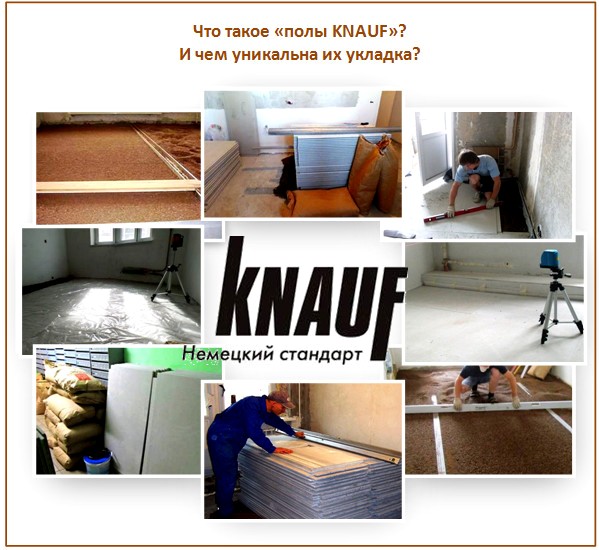


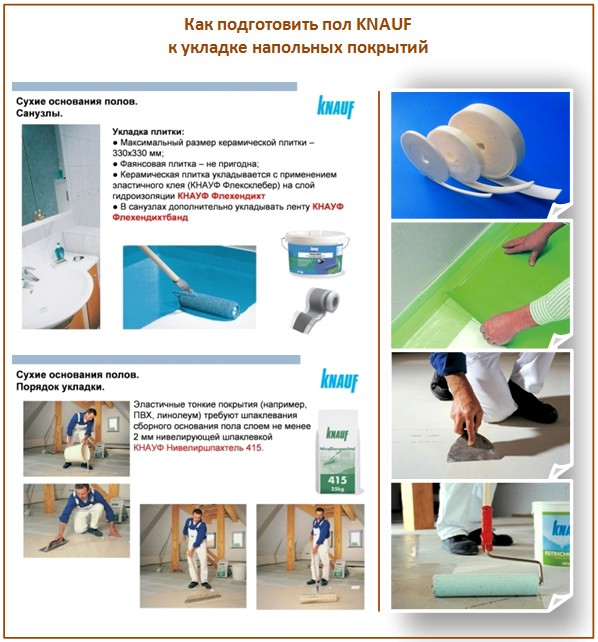
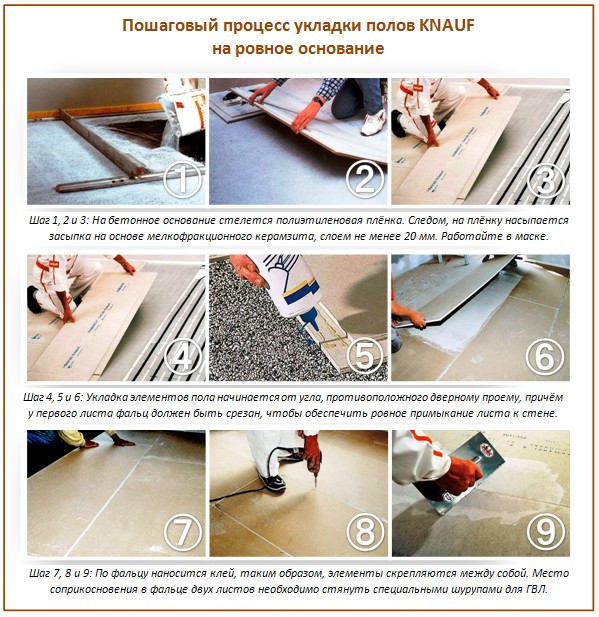
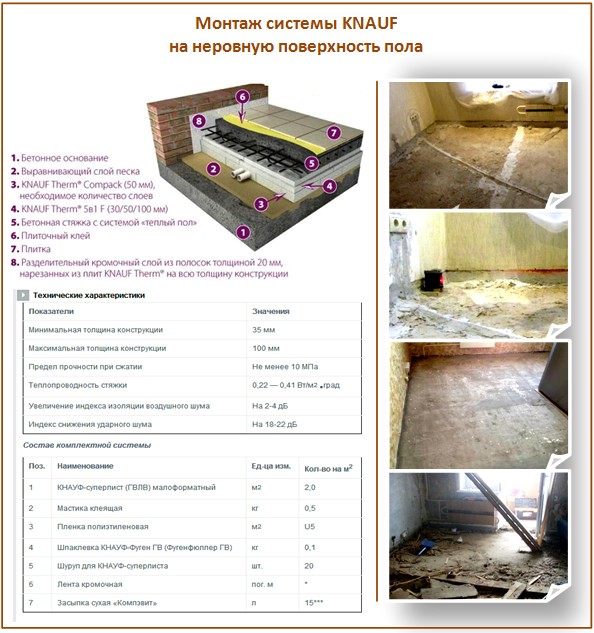
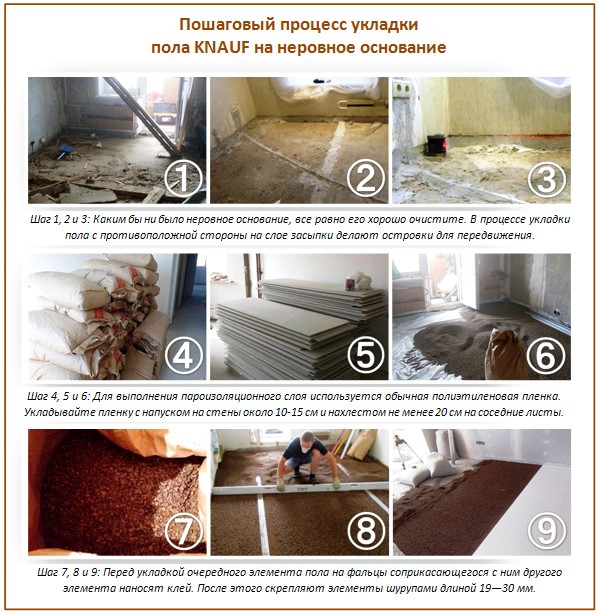

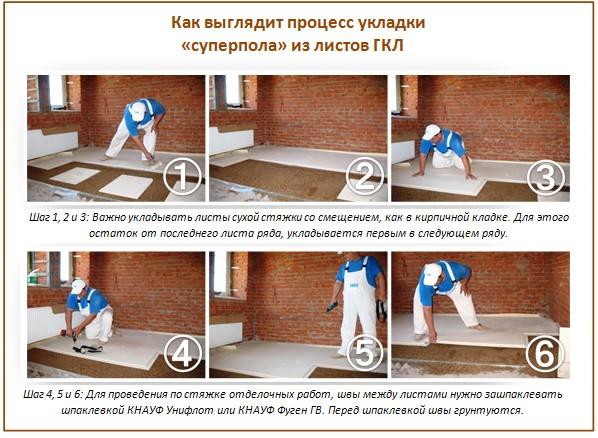
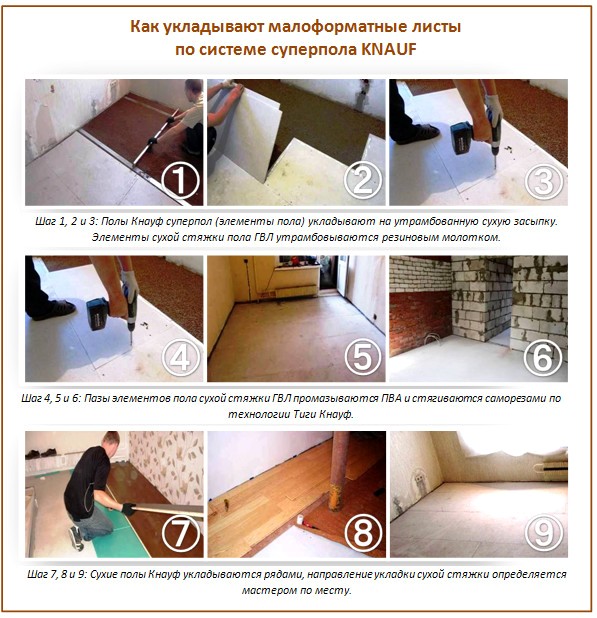
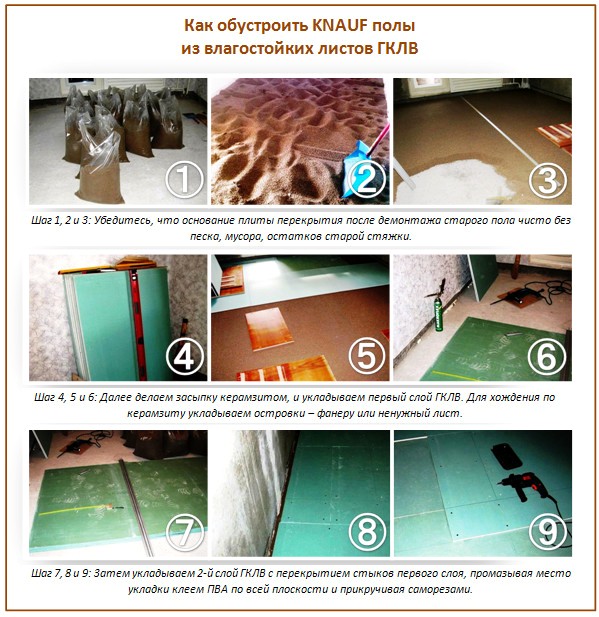
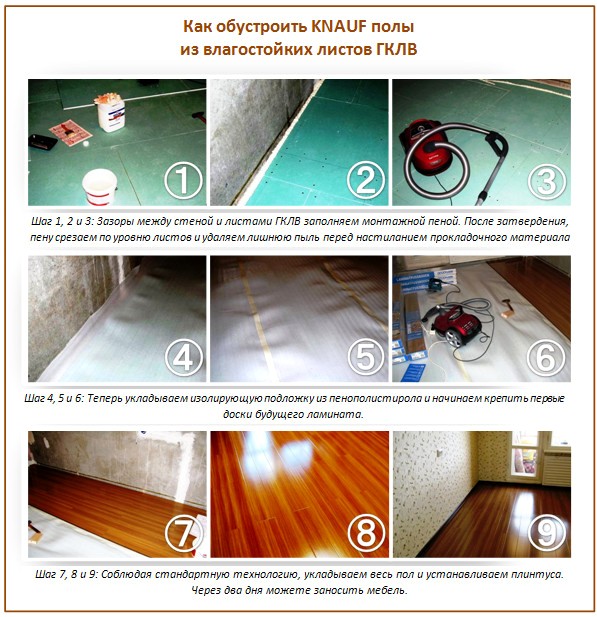
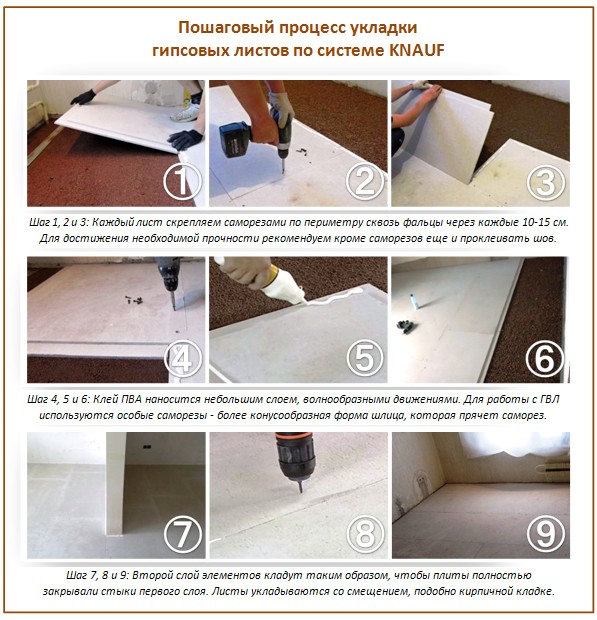
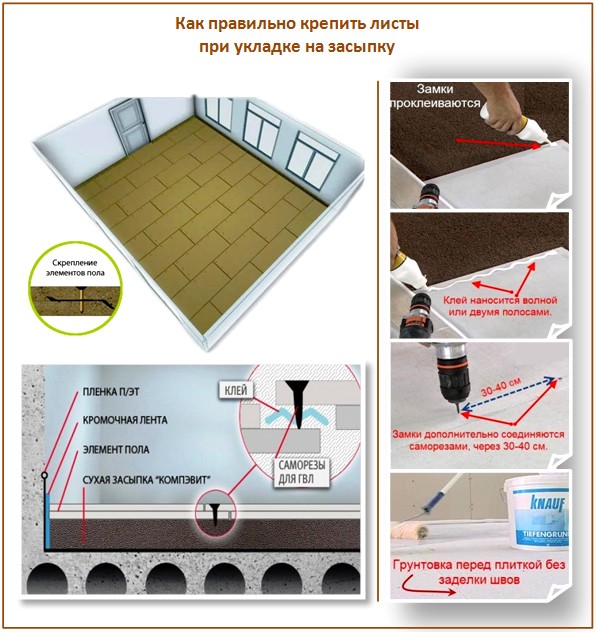
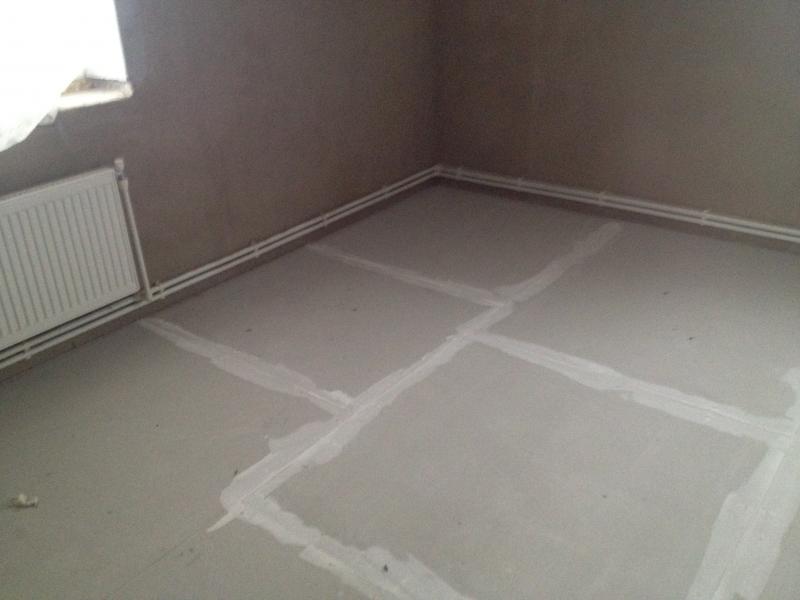
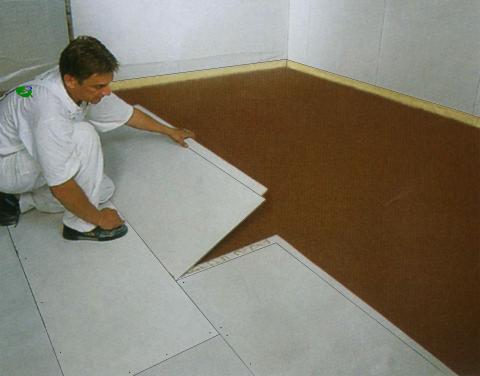

1 comment